David Petersen's Blog, page 31
December 24, 2019
YouTube Channel
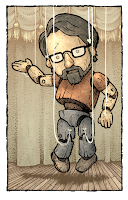 Just a Blogpost reminder about my YouTube channel where I share Mouse Guard readings & songs, Tutorials, Architectural Models, Game info, Plotmasters Project episodes, Creator Commentary, and more!
Just a Blogpost reminder about my YouTube channel where I share Mouse Guard readings & songs, Tutorials, Architectural Models, Game info, Plotmasters Project episodes, Creator Commentary, and more! The channel has 60+ videos already--with more soon on the way. Make sure to click 'subscribe' and the bell icon over on YouTube so you can get alerts when new videos go live:https://www.youtube.com/c/DavidPetersenChannel
Mouse Guard Readings
Tale of the Wise Weaver
Tale of Baldwin the Brave
Tale of Thane & Ilsa
The Watcher's Stoneby Ryan Lang – performed by David Petersen
The Timber MicePerformed by Kyra Sims & Jordan Shapiro Illustrated by Justin Gerard
Lyrics: David Petersen – Melody: Cliff Monear
Legends of the Guard Vol.1 Cover Legends
Legends of the Guard Vol.2 Cover Legends
Legends of the Guard Vol.3 Cover Legends
The Tale of the Wild Wolf
The Tale of Piper The Listener
Fall 1152 LIVE Reading
Creator Commentary
Fall 1152: Chapter 1
Fall 1152: Chapter 2
Fall 1152: Chapter 3
Fall 1152: Chapter 4
Fall 1152: Chapter 5
Fall 1152: Chapter 6
Fall 1152: Hardcover Extras
Legends of the Guard: 'Potential'
with Alex Kain & Sean Rubin
Winter 1152: Chapter 1
Winter 1152: Chapter 2
Winter 1152: Chapter 3
Winter 1152: Chapter 4
Winter 1152: Chapter 5
Winter 1152: Chapter 6
Winter 1152: Hardcover Extras
Legends of the Guard:'The Battle of the Hawk's Mouse
& the Fox's Mouse'
with Jeremy Bastian
Architectural Models
Coin Horde Chamber Column
Leaf Boat
Barrel Carrier
Quail Cart
A Ship of Shell & Timber Scrap
The Red Snapper
Puppet Theater
Seyan Gatehouse
Upper Port Sumac
Gwendolyn's Office
Matriarch's Chamber
Sprucetuck
Feather Knighting Room
Haven Guildroom
Lockhaven Larder
Shorestone Exterior
Wind in the Willows: Toad Hall Foyer
Wind in the Willows:
Toad Hall Dining Room
Wind in the Willows:
Toad's Caravan
Wind in the Willows:
Toad Hall Carriage House
Wind in the Willows:
Badger's Hearth
Wind in the Willows:
Badger's Cupboard
Wind in the Willows:
Rat's Dining Area
Wind in the Willows:Rat's Boat
Mouse Guard Games
Swords & Strongholds:
Game Rules
Swords & Strongholds:
Common Questions
Swords & Strongholds:
Play Example
Mouse Guard RPG Info
Plotmasters Project
Cats Trio
Quietus
Blackcat
Dragons pt 1
Dragons pt 2
2017 Baltimore Panel
Demonstrations &
Lectures
Ladybug: Line Art/Levels Demo
Ladybug: Color Hold Demo
Ladybug: Color Demo
Mouse Guard Speed Color 1
Mouse Guard Speed Color 2
Mouse Guard Speed Color 3
Mouse Guard Speed Color 4
Mouse Guard Speed Color 5
Mouse Guard Speed Color 6
Mouse Guard Speed Color 7
Mouse Guard Speed Color 8
Mouse Guard Speed Color 9
Misc.
Ringo Awards Keynote Speech
Snowy Valentine Promo
Mouse Guard Book Trailer
Published on December 24, 2019 06:00
December 17, 2019
Lily Redfur -A Fan's Cosplay Character-
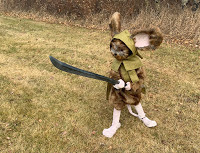
Just after Halloween this year I was contacted by a father who helped his four-year-old daughter make a Mouse Guard costume for her of her mouse alter-ego Lily.
Dad Jason writes: "I'll try to describe Lily and her patrol to you in as few words as I can manage, we're fond of our patrol and their adventures pass the time in the car and have also become a part of many bedtime stories.
Lily is an excellent archer and prefers to strike her targets from far above in the trees, but is skilled enough with a sword that she isn't afraid to fight in close if necessary. She is bubbly and positive and makes friends easily. She has reddish-brown fur and a light green cloak. She is the hero of our tales and is a true out of the box thinker (as only a hero controlled by a 4-year-old can be!)"
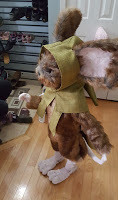
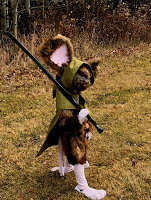

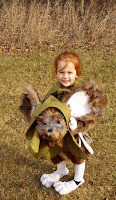
So, with a special as this fan family is, I did a drawing of Lily Redfur that should now be safely in her paws.
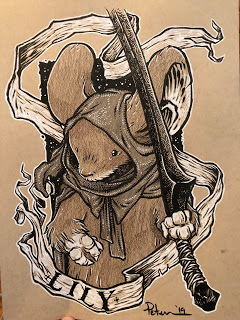
2020 Appearances Coming Soon...
Published on December 17, 2019 06:00
December 10, 2019
Comic Storytelling Workshop basics
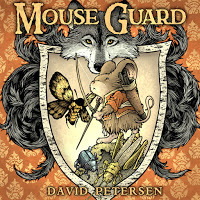 A few weeks ago I was an instructor at the 1FW Workshop where I was asked to lead a small group discussion about comic storytelling. In the year prior when I was an instructor, I didn't do much prep for my small group talks, expecting that they'd be a bit more like round-table discussions...but this year I wanted to come prepared.
A few weeks ago I was an instructor at the 1FW Workshop where I was asked to lead a small group discussion about comic storytelling. In the year prior when I was an instructor, I didn't do much prep for my small group talks, expecting that they'd be a bit more like round-table discussions...but this year I wanted to come prepared.So I loaded on my iPad the script, layouts/pencils, inks, and final colors/letters to be able to show my process and help demystify the process before opening up to attendees' specific comic storytelling questions and concerns. In this post, I'll share those materials, from the FCBD story: 'The Tale of the Wild Wolf'
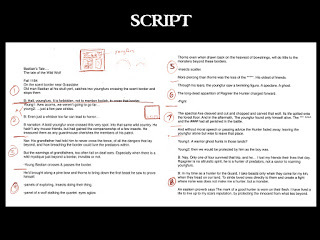
SCRIPT:
This 8 page story started with an outline/script. I tend not to over-write, or even break down beats into panels. I'm bad with denoting what is a word balloon of dialogue, what is narration text, and what is description for me to know what's happening. But that's also because as the writer AND artist, I can be a little more loose with this process. It's like an idea purge. I'm just trying to get it all out before I worry about how it fits into panels or what scenes are on which pages.
I'll then print out my script and mark it up with pencil to make notes of where page breaks seem like they fit. Sometimes that's based on experience of knowing what could/should fit on a page, while other times, it's just a gut feeling that the break should be...there. I may doodle up some thumbnails or make notes about some bit being its own panel...but I leave a lot of that for the next step.
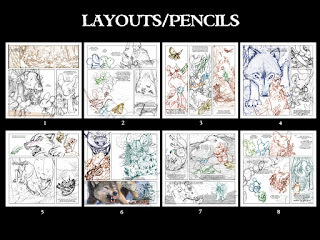
LAYOUTS/PENCILS:I'll then start pasting all the dialogue and narration into a photoshop template I have for my pages, giving each page the text that my marked up scrip calls for. I almost always break my panels on the 1/3 lines of the page, and then make decisions about scenes and how they'll fit. Sometimes the most important bit in a scene needs to be a certain shape (tall, wide, big) and then I have to just puzzle in the other panels around it--other times it's about needing a certain number of beats (this happens and then I need two reaction panels, or I need to show the before, during and after of an action)
I draw characters and panel backgrounds on copy paper often drawing those elements separately, then scanning them and combining them in my page template. That way I can resize, rotate, and manipulate each element individually (the various parts of the drawing tinted different colors gives you a clue as to what are different drawings). The wolf photo on page 6 was a cheat after I'd already drawn a wolf there I hated, inked it, and woke up the next morning with the deadline looming feeling the need to change it...and hopefully in my next step, I didn't make it look like a photo trace, but a seamless part of my artwork...
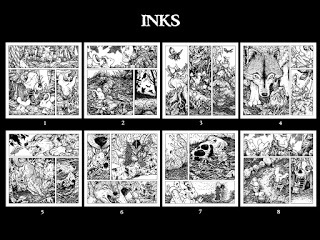
INKS:I print out each of my page layouts and then tape them to the back of bristol board. On my lightpad I'm able to see through the surface of the bristol to use the printout underneath to guide me as I ink..
Here I add all the texture and line weight, pattern, and density that helps turn a pencil sketch into a real inked panel. And making sure that I applied all my stylistic mark making to the wolf on page 6, it doesn't look out of place or an overly photo referenced panel compared to the others.

FINAL PAGES:With the inks finished, I scan them and then color them digitally. This story has a large flashback, so I gave it an orangey-sepia style color story. With the colors set, I also add the balloons and dialogue boxes and make final polishes to the lettering.
If you'd like to hear me perform this story, I have it below or on my YouTube channel with other readings of Mouse Guard stories as well as creator commentary, model videos, and more
2020 Appearances Coming Soon...
Published on December 10, 2019 06:00
December 3, 2019
Model Building Workshop Session
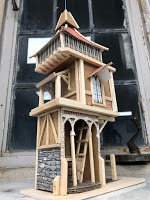 A few weeks ago I was an instructor at the 1FW Workshop. And as a hands-on demonstration, led a group in building an architectural model. My goal wasn't so much to show how useful they are––both for drawing complex geometric perspective from any angle, but also in exploring a space for the right composition...but instead to show that it was possible for them to make these themselves. That the time commitment isn't outrageous, it doesn't take a lot of building knowledge, or special materials, or expensive tools.
A few weeks ago I was an instructor at the 1FW Workshop. And as a hands-on demonstration, led a group in building an architectural model. My goal wasn't so much to show how useful they are––both for drawing complex geometric perspective from any angle, but also in exploring a space for the right composition...but instead to show that it was possible for them to make these themselves. That the time commitment isn't outrageous, it doesn't take a lot of building knowledge, or special materials, or expensive tools.In this blogpost I'll go over the basics of what I showed them.
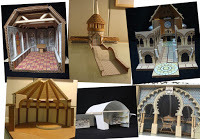 I started with photos of some of my Mouse Guard architectural models. I wanted to give them a smattering of some that were interior and some that were exterior, some that had little applied details (used just for geometry) and some that had lots of paper textures applied. Some were only a few pieces of cardstock, and some were much more complex plywood that had to be cut and drilled with power tools to achieve. The point was that you can make these as complex and detailed or simple and basic as you have the time, experience, and tools for.
I started with photos of some of my Mouse Guard architectural models. I wanted to give them a smattering of some that were interior and some that were exterior, some that had little applied details (used just for geometry) and some that had lots of paper textures applied. Some were only a few pieces of cardstock, and some were much more complex plywood that had to be cut and drilled with power tools to achieve. The point was that you can make these as complex and detailed or simple and basic as you have the time, experience, and tools for.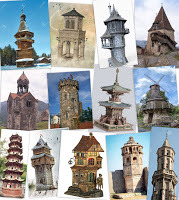 Then I announced the project itself: we were going to group build a tower. I loaded my iPad with Google image search results of various towers. I tired to get a variety of towers. Ones that were widest at the base and tapered smaller all the way to the peak. Towers that had a wider top level, towers from various cultures, towers with function, towers that were decorative, and symmetrical & asymmetrical towers.
Then I announced the project itself: we were going to group build a tower. I loaded my iPad with Google image search results of various towers. I tired to get a variety of towers. Ones that were widest at the base and tapered smaller all the way to the peak. Towers that had a wider top level, towers from various cultures, towers with function, towers that were decorative, and symmetrical & asymmetrical towers.And our goal wasn't to recreate one of these exactly, but to pick out design choices we liked as a group to include into our model.
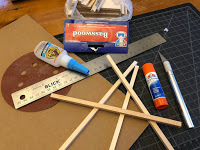 Next was the presenting of materials:
Next was the presenting of materials:Cardboard (single and double corrugated––all scavenged shipping boxes), rulers, x-acto knives, a cutting mat, a pack of basswood scraps (purchased at a local hobby store), sandpaper (using up discs I have for a palm sander that bit the dust years ago) and 3 types of glue: Hot Melt (not pictured) for anything structural, Super Glue for anything that required finesse, and glue stick for applying paper patterns and details to flat surfaces (I'd usually use spray adhesive here, but to cut down on mess, I went with glue stick)...
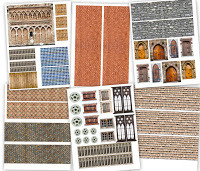 And lastly, sheets and sheets of patterns and textures and building elements I cobbled together from Google image searches printed out on copy paper.
And lastly, sheets and sheets of patterns and textures and building elements I cobbled together from Google image searches printed out on copy paper.For my models, I'd print these as-needed and to the exact scale my model required...but for the workshop I just came prepared with a half dozen sheets of shingles, brick, stone, tiles, pavers, arches, wood elements, windows, doors and more.
The group was well attended. My only regret is that to get them started, I spent a lot of time building a lot of the first section myself instead of having them get in there and get into it faster. But, I did put knives and glue and paper and trim in their paws and got them making decisions about our tower.
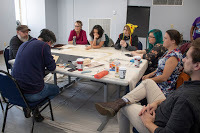
One of the things I tried to impress on them was how rarely I measure using numbers. I'll cut something to a length that I like...say a wall, and then use that to trace to make the corresponding wall. Our use my thumb on a ruler as a depth gauge to mark out a piece. Sometimes setting the model down on a fresh sheet of cardboard to mark out the size the 2nd floor should be so that it overhangs the walls of the first floor. It's something my Dad taught me when woodworking, and something I still use to this day when building something for myself.
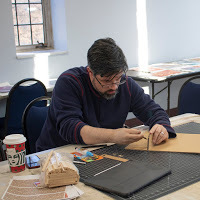
The session was a few hours and we got a good hunk of work done (unfortunately I don't have a photo of where we were when the group had to disband for the next workshop event), but we kept the space set-up so that in the free-work time later that night folks could come back up and continue to push the model forward. And with the help of some of the students (some that were in the first session and some that joined us anew in the evening) we finished this tower model:
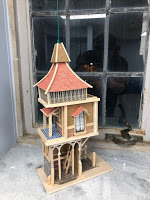
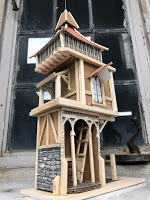
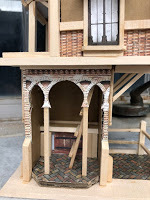
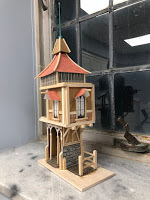
If you have more interest in my architectural models, I have a YouTube Playlist here showing several of the models, materials I used to make them and how they helped me illustrate my stories:
2020 Appearances Coming Soon...
Published on December 03, 2019 06:00
November 26, 2019
Thankful for Mouse Guard contributors
While Mouse Guard is known as being my one-man show when it comes to the main book, I am so very thankful for the huge community of artists who have helped flesh out the visuals to the Mouse Guard books in their contributions of pinups, Legends of the Guard stories, and variant covers. Hopefully the volume of work in this post not only inspires all of you about the Mouse Territories and what lies beyond (and ahead), but also to show that no Guardmouse stands alone (even me).
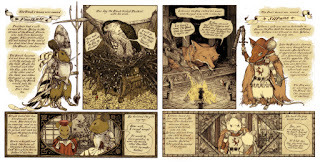 Jeremy Bastian(Pinups in Fall & story in Legends of the Guard Vol.1)jeremybastian.ink
Jeremy Bastian(Pinups in Fall & story in Legends of the Guard Vol.1)jeremybastian.ink
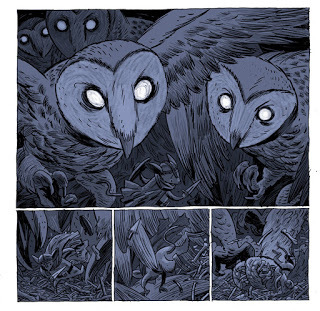 Guy Davis
Guy Davis
(Pinups in Fall & story in Legends of the Guard Vol.1)guydavisartworks.com
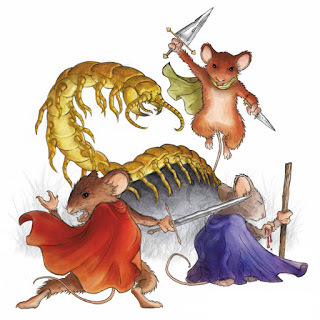 Rick Cortes
Rick Cortes
(Pinup in Fall)Instagram
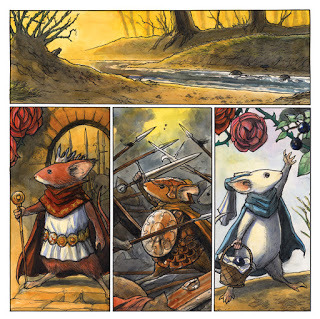 Mark Smylie
Mark Smylie
(Pinup in Fall & story in Legends of the Guard Vol.1)swordandbarrow.com
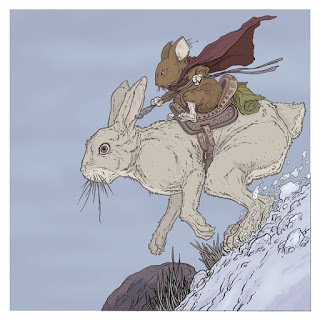 Geof Darrow
Geof Darrow
(Pinup in Winter)Twitter
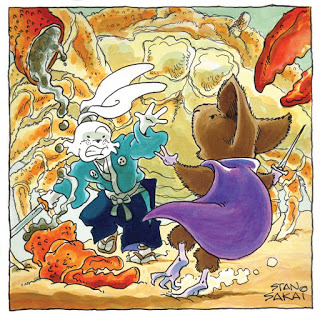 Stan Sakai
Stan Sakai
(Pinup in Winter & story in Legends of the Guard Vol.2)stansakai.com/
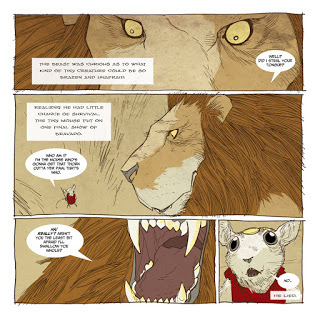 Craig Rousseau
Craig Rousseau
(Pinup in Winter & story in Legends of the Guard Vol.1)
www.craigrousseau.com
 Nate Pride
Nate Pride
(Pinup in Winter & story in Legends of the Guard Vol.1)Tumblr
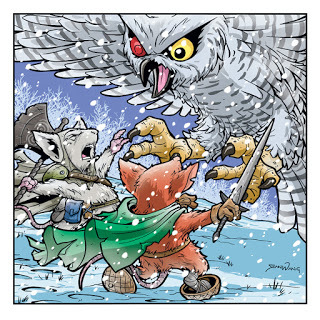 Sean Wang(Pinup in Winter)seanwang.com
Sean Wang(Pinup in Winter)seanwang.com
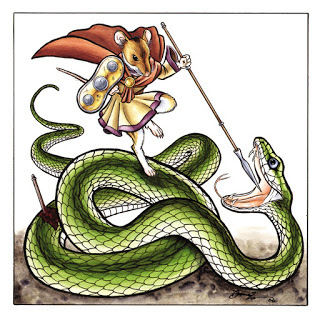 Jane Irwin
Jane Irwin
(Pinup in Winter)fierystudios.com
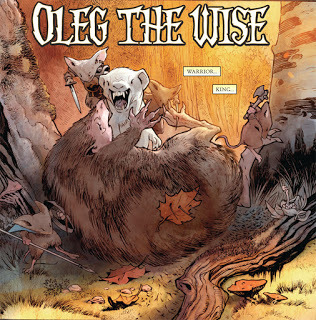 Alex Sheikman(Pinup in Black Axe & story in Legends of the Guard Vol.1)
Alex Sheikman(Pinup in Black Axe & story in Legends of the Guard Vol.1)
sheikman.blogspot.com
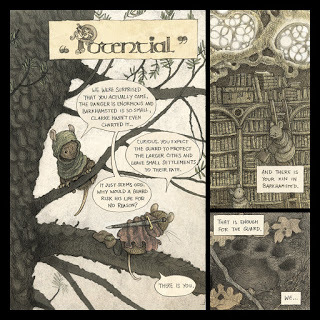 Sean Rubin (story by Alex Kain)(Pinup in Black Axe & story in Legends of the Guard Vol.1)seanrubin.com
Sean Rubin (story by Alex Kain)(Pinup in Black Axe & story in Legends of the Guard Vol.1)seanrubin.com
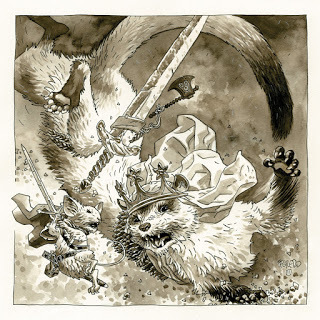 Duncan Fegredo(Pinup in Black Axe)
Duncan Fegredo(Pinup in Black Axe)
duncanfegredo.co.uk
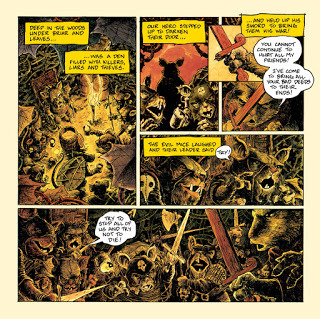 C. P. Wilson III(Pinup in Black Axe & story in Legends of the Guard Vol.2)
C. P. Wilson III(Pinup in Black Axe & story in Legends of the Guard Vol.2)
Twitter
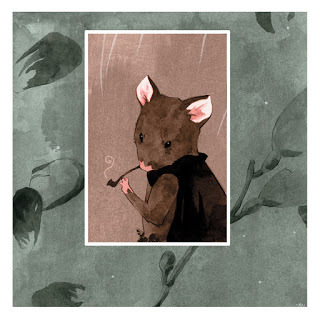 S.M. Vidaurri(Pinup in Black Axe)smvidaurri.com
S.M. Vidaurri(Pinup in Black Axe)smvidaurri.com
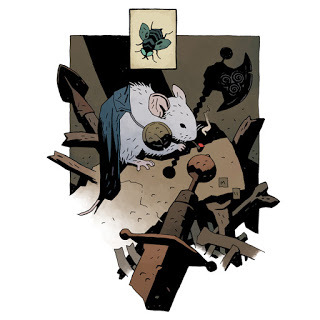 Mike Mignola(Pinup in Black Axe)artofmikemignola.com
Mike Mignola(Pinup in Black Axe)artofmikemignola.com
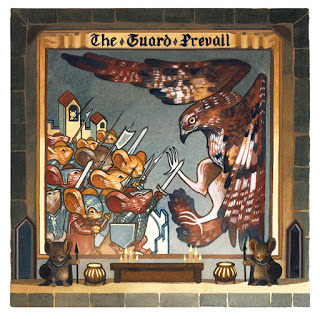 Serena Malyon
Serena Malyon
(Illustrated the Alphabet Book)
serenamalyon.com
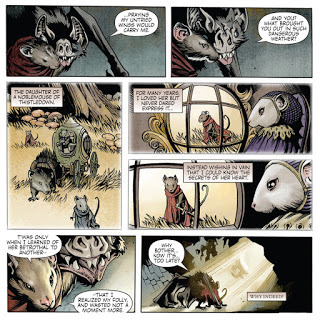 Ted Naifeh(Story in Legends of the Guard Vol.1)
Ted Naifeh(Story in Legends of the Guard Vol.1)
tednaifeh.com
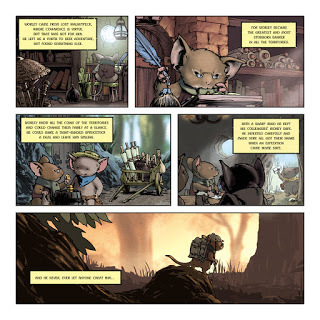 Gene Ha (Story by Lowell Francis)(Story in Legends of the Guard Vol.1)
Gene Ha (Story by Lowell Francis)(Story in Legends of the Guard Vol.1)
geneha.com
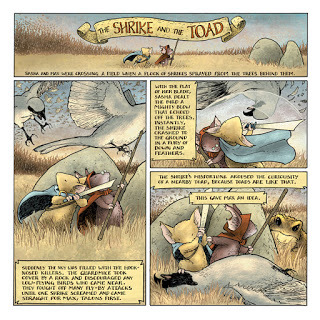 Terry Moore
Terry Moore
(Story in Legends of the Guard Vol.1)abstractstudiocomics.com
 Katie Cook
Katie Cook
(Story in Legends of the Guard Vol.1)
katiecandraw.com
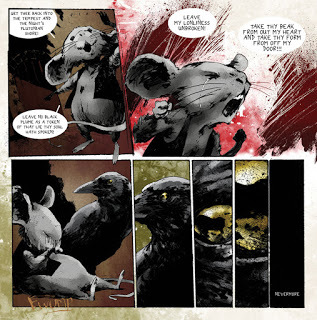 Jason-Shawn Alexander
Jason-Shawn Alexander
(Story in Legends of the Guard Vol.1)
studiojsa.com
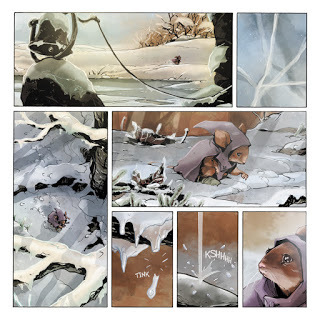 Karl Kerschl(Story in Legends of the Guard Vol.1)
Karl Kerschl(Story in Legends of the Guard Vol.1)
karlkerschl.com
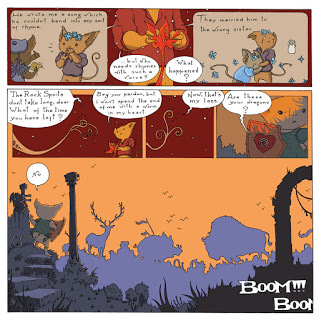 João Lemos
João Lemos
(Epilogue in Legends of the Guard Vol.1)
Website
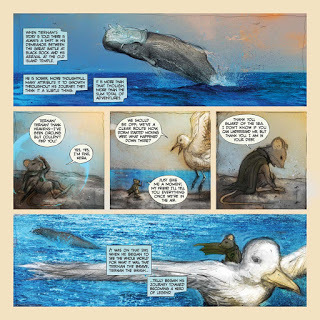
Alex Eckman-Lawn
(story by Nick Tapalansky)(Story in Legends of the Guard Vol.2)
alexeckmanlawn.com
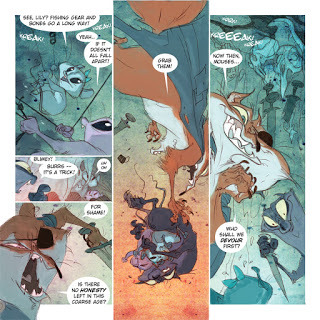
Ben Caldwell(Story in Legends of the Guard Vol.2)Twitter
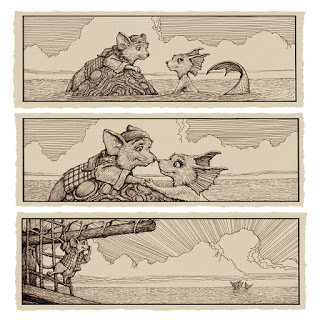 Christian Slade(Story in Legends of the Guard Vol.2)
Christian Slade(Story in Legends of the Guard Vol.2)
christianslade.com
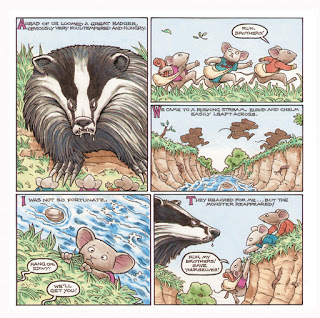 Rick Geary
Rick Geary
(Story in Legends of the Guard Vol.2)
rickgeary.com
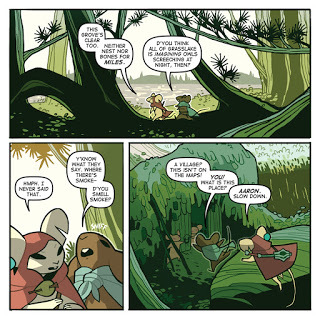 Jemma Salume
Jemma Salume
(Story in Legends of the Guard Vol.2)
Tumblr
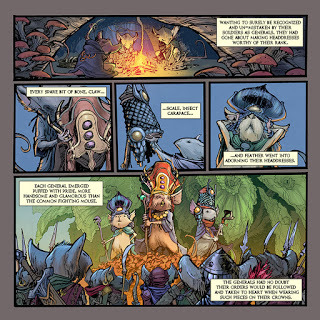 Eric Canete
Eric Canete
(Story in Legends of the Guard Vol.2)Twitter
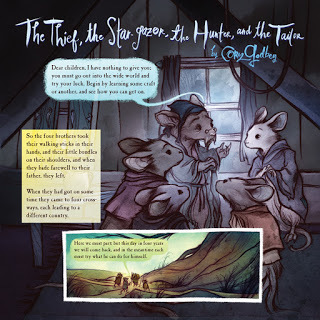 Cory Godbey
Cory Godbey
(Story in Legends of the Guard Vol.2)corygodbey.com
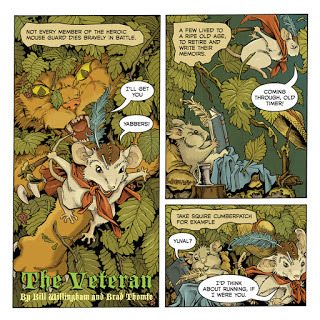 Bill Willingham
Bill Willingham
(Story in Legends of the Guard Vol.2)Twitter
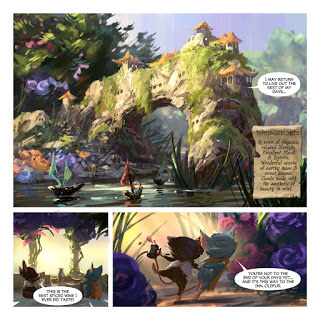 Jackson Sze
Jackson Sze
(Story in Legends of the Guard Vol.2)
Instagram
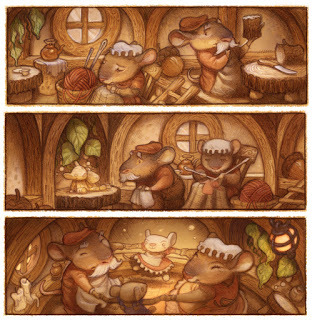 Justin Gerard
Justin Gerard
(Story in Legends of the Guard Vol.2)
gallerygerard.com
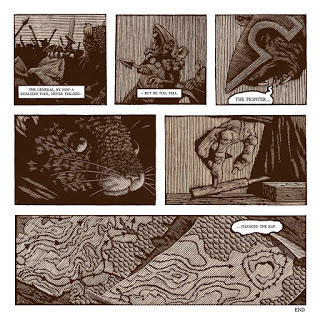 Dirk Shearer(Epilogue in Legends of the Guard Vol.2)
Dirk Shearer(Epilogue in Legends of the Guard Vol.2)
dirkshearer.com
 Mark Buckingham
Mark Buckingham
(Story in Legends of the Guard Vol.3)
Facebook
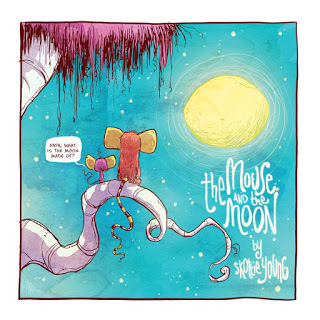 Skottie Young(Story in Legends of the Guard Vol.3)
Skottie Young(Story in Legends of the Guard Vol.3)
skottieyoung.com
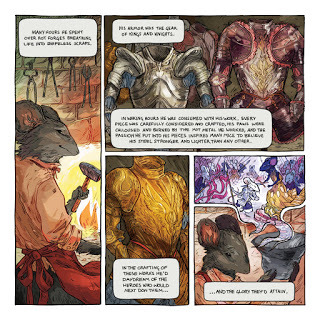 Hannah Lavender
Hannah Lavender
(Story in Legends of the Guard Vol.3)
studiolavender.com
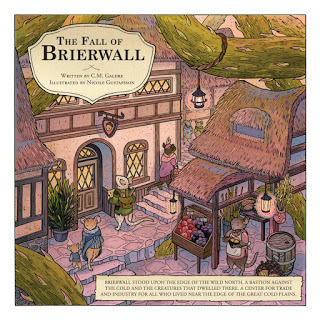 Nicole Gustafsson
Nicole Gustafsson
(Story by C.M. Galdre)
(Story in Legends of the Guard Vol.3)
nimasprout.com
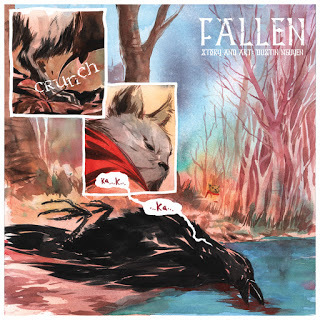 Dustin Nguyen
Dustin Nguyen
(Story in Legends of the Guard Vol.3)
Instagram
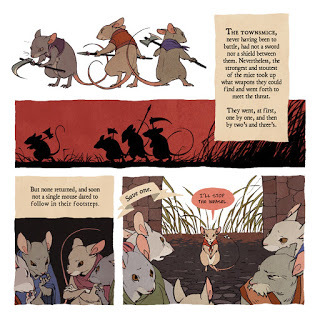 Kyla Vanderklugt
Kyla Vanderklugt
(Story in Legends of the Guard Vol.3)
kylavanderklugt.com
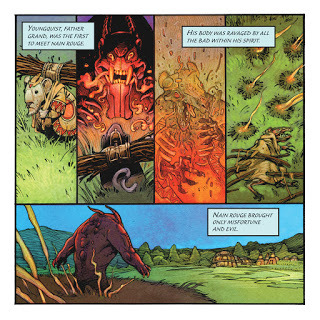 Mark A. Nelson
Mark A. Nelson
(Story in Legends of the Guard Vol.3)
ArtStation
 Jake Parker(Story in Legends of the Guard Vol.3)mrjakeparker.com
Jake Parker(Story in Legends of the Guard Vol.3)mrjakeparker.com
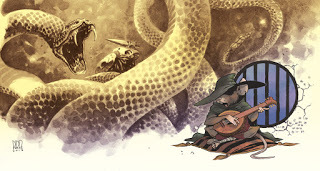 Ramon K. Pérez(Story in Legends of the Guard Vol.3 & Variant Legends Cover)ramonperez.com
Ramon K. Pérez(Story in Legends of the Guard Vol.3 & Variant Legends Cover)ramonperez.com
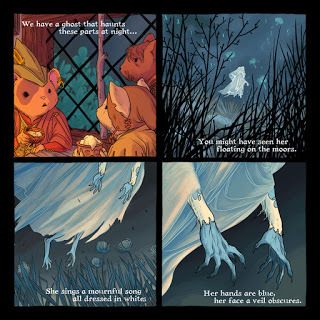 Becky Cloonan
Becky Cloonan
(Story in Legends of the Guard Vol.3)
beckycloonan.net
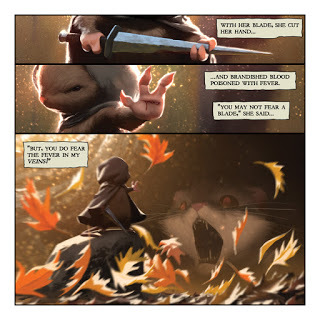 Ryan Lang
Ryan Lang
(Story in Legends of the Guard Vol.3)
ArtStation
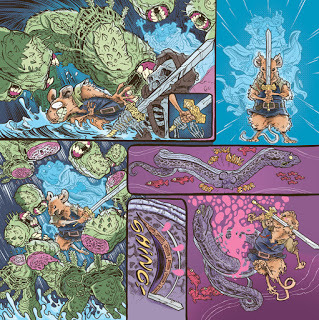 Aaron Conley
Aaron Conley
(Story by Fabian Rangel Jr.)
(Story in Legends of the Guard Vol.3)Twitter
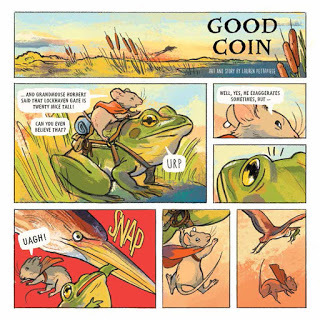 Lauren Pettapiece
Lauren Pettapiece
(Epilogue in Legends of the Guard Vol.3)
laurenpettapiece.com
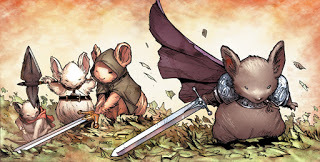 Humberto Ramos
Humberto Ramos
(Variant Legends Cover)
Instagram
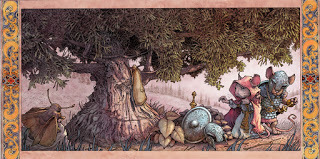 Eric Muller
Eric Muller
(Variant Legends Cover)
DeviantArt
2020 Appearances Coming Soon...
 Jeremy Bastian(Pinups in Fall & story in Legends of the Guard Vol.1)jeremybastian.ink
Jeremy Bastian(Pinups in Fall & story in Legends of the Guard Vol.1)jeremybastian.ink Guy Davis
Guy Davis(Pinups in Fall & story in Legends of the Guard Vol.1)guydavisartworks.com
 Rick Cortes
Rick Cortes(Pinup in Fall)Instagram
 Mark Smylie
Mark Smylie(Pinup in Fall & story in Legends of the Guard Vol.1)swordandbarrow.com
 Geof Darrow
Geof Darrow(Pinup in Winter)Twitter
 Stan Sakai
Stan Sakai(Pinup in Winter & story in Legends of the Guard Vol.2)stansakai.com/
 Craig Rousseau
Craig Rousseau(Pinup in Winter & story in Legends of the Guard Vol.1)
www.craigrousseau.com
 Nate Pride
Nate Pride(Pinup in Winter & story in Legends of the Guard Vol.1)Tumblr
 Sean Wang(Pinup in Winter)seanwang.com
Sean Wang(Pinup in Winter)seanwang.com Jane Irwin
Jane Irwin(Pinup in Winter)fierystudios.com
 Alex Sheikman(Pinup in Black Axe & story in Legends of the Guard Vol.1)
Alex Sheikman(Pinup in Black Axe & story in Legends of the Guard Vol.1)sheikman.blogspot.com
 Sean Rubin (story by Alex Kain)(Pinup in Black Axe & story in Legends of the Guard Vol.1)seanrubin.com
Sean Rubin (story by Alex Kain)(Pinup in Black Axe & story in Legends of the Guard Vol.1)seanrubin.com Duncan Fegredo(Pinup in Black Axe)
Duncan Fegredo(Pinup in Black Axe)duncanfegredo.co.uk
 C. P. Wilson III(Pinup in Black Axe & story in Legends of the Guard Vol.2)
C. P. Wilson III(Pinup in Black Axe & story in Legends of the Guard Vol.2) S.M. Vidaurri(Pinup in Black Axe)smvidaurri.com
S.M. Vidaurri(Pinup in Black Axe)smvidaurri.com Mike Mignola(Pinup in Black Axe)artofmikemignola.com
Mike Mignola(Pinup in Black Axe)artofmikemignola.com Serena Malyon
Serena Malyon(Illustrated the Alphabet Book)
serenamalyon.com
 Ted Naifeh(Story in Legends of the Guard Vol.1)
Ted Naifeh(Story in Legends of the Guard Vol.1)tednaifeh.com
 Gene Ha (Story by Lowell Francis)(Story in Legends of the Guard Vol.1)
Gene Ha (Story by Lowell Francis)(Story in Legends of the Guard Vol.1)geneha.com
 Terry Moore
Terry Moore(Story in Legends of the Guard Vol.1)abstractstudiocomics.com
 Katie Cook
Katie Cook(Story in Legends of the Guard Vol.1)
katiecandraw.com
 Jason-Shawn Alexander
Jason-Shawn Alexander(Story in Legends of the Guard Vol.1)
studiojsa.com
 Karl Kerschl(Story in Legends of the Guard Vol.1)
Karl Kerschl(Story in Legends of the Guard Vol.1)karlkerschl.com
 João Lemos
João Lemos(Epilogue in Legends of the Guard Vol.1)
Website

Alex Eckman-Lawn
(story by Nick Tapalansky)(Story in Legends of the Guard Vol.2)
alexeckmanlawn.com

Ben Caldwell(Story in Legends of the Guard Vol.2)Twitter
 Christian Slade(Story in Legends of the Guard Vol.2)
Christian Slade(Story in Legends of the Guard Vol.2)christianslade.com
 Rick Geary
Rick Geary(Story in Legends of the Guard Vol.2)
rickgeary.com
 Jemma Salume
Jemma Salume(Story in Legends of the Guard Vol.2)
Tumblr
 Eric Canete
Eric Canete(Story in Legends of the Guard Vol.2)Twitter
 Cory Godbey
Cory Godbey(Story in Legends of the Guard Vol.2)corygodbey.com
 Bill Willingham
Bill Willingham(Story in Legends of the Guard Vol.2)Twitter
 Jackson Sze
Jackson Sze(Story in Legends of the Guard Vol.2)
 Justin Gerard
Justin Gerard(Story in Legends of the Guard Vol.2)
gallerygerard.com
 Dirk Shearer(Epilogue in Legends of the Guard Vol.2)
Dirk Shearer(Epilogue in Legends of the Guard Vol.2)dirkshearer.com
 Mark Buckingham
Mark Buckingham(Story in Legends of the Guard Vol.3)
 Skottie Young(Story in Legends of the Guard Vol.3)
Skottie Young(Story in Legends of the Guard Vol.3)skottieyoung.com
 Hannah Lavender
Hannah Lavender(Story in Legends of the Guard Vol.3)
studiolavender.com
 Nicole Gustafsson
Nicole Gustafsson (Story by C.M. Galdre)
(Story in Legends of the Guard Vol.3)
nimasprout.com
 Dustin Nguyen
Dustin Nguyen(Story in Legends of the Guard Vol.3)
 Kyla Vanderklugt
Kyla Vanderklugt(Story in Legends of the Guard Vol.3)
kylavanderklugt.com
 Mark A. Nelson
Mark A. Nelson(Story in Legends of the Guard Vol.3)
ArtStation
 Jake Parker(Story in Legends of the Guard Vol.3)mrjakeparker.com
Jake Parker(Story in Legends of the Guard Vol.3)mrjakeparker.com Ramon K. Pérez(Story in Legends of the Guard Vol.3 & Variant Legends Cover)ramonperez.com
Ramon K. Pérez(Story in Legends of the Guard Vol.3 & Variant Legends Cover)ramonperez.com Becky Cloonan
Becky Cloonan(Story in Legends of the Guard Vol.3)
beckycloonan.net
 Ryan Lang
Ryan Lang(Story in Legends of the Guard Vol.3)
ArtStation
 Aaron Conley
Aaron Conley (Story by Fabian Rangel Jr.)
(Story in Legends of the Guard Vol.3)Twitter
 Lauren Pettapiece
Lauren Pettapiece(Epilogue in Legends of the Guard Vol.3)
laurenpettapiece.com
 Humberto Ramos
Humberto Ramos(Variant Legends Cover)
 Eric Muller
Eric Muller(Variant Legends Cover)
DeviantArt
2020 Appearances Coming Soon...
Published on November 26, 2019 06:00
November 19, 2019
Recent Commissions
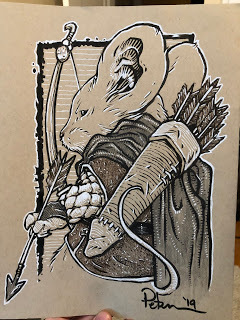 Guardmouse Archer
Guardmouse Archer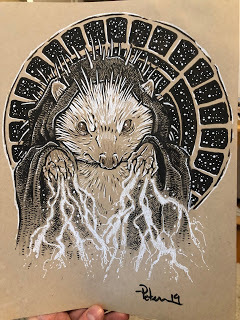 Sith Hedgehog
Sith Hedgehog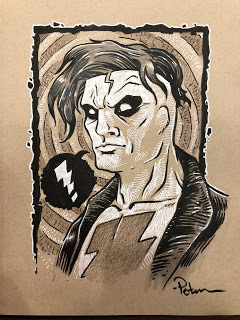 Mike Alred's Madman
Mike Alred's Madman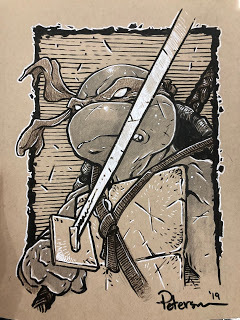 Leonardo of the TMNT
Leonardo of the TMNT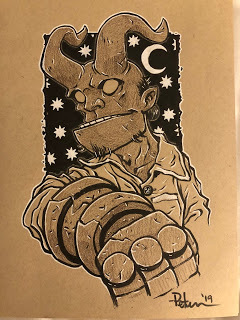 Young Hellboy
Young Hellboy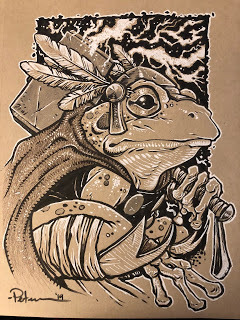 Throg (Frog Thor)
Throg (Frog Thor)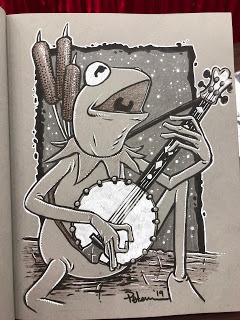 Kermit
Kermit2019 Appearances
The Fantastic Workshop Nov. 13-18
Published on November 19, 2019 06:00
November 12, 2019
Words & Pictures: Hybrid Books
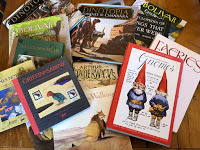
Last year at the 1 Fantastic Workshop there were a number of students who expressed interest in making a book of their artwork that incorporated text––more illustrations than an illustrated novel, more words than a picture book...perhaps with some comic pages...but not all comic. It's a hard blend to achieve. And even when it's done well, (the examples I''ll show in this post are from my own bookshelves and some of the best hybridizations of words & pictures) some lean more towards picture books, or illustrated novels, or field guides, or comics.
I've provided links to every book on Amazon. It appears some are out of print or have new editions unlike what I have pictured.
Coyote Goes Walking &
Crow and WeaselBoth of these books are illustrated by Tom Pohrt––one is written by Barry Lopez and the other is written re-tellings of traditional Native American trickster stories.
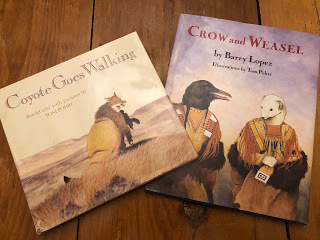
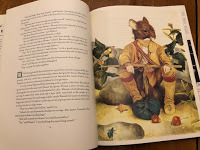
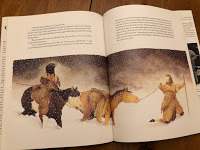
Visually Crow and Weasel and Coyote Goes Walking are more like picture books...but Crow and Weasel is more like a novella. It has full pages of text, but the illustrations are large, often full pages. There are a few spots where there are consecutive pages of text with no illustration but the ratio of text to art puts this book on my list. There's nothing that really integrates the text into the artwork (other than some historiated initials at the start of a paragraph or section.)
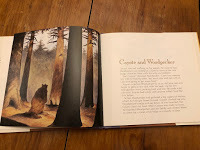
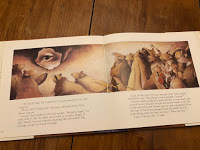
Coyote Goes Walking definitely leans towards being a picture book...but I selected it for this list because while there is an illustration roughly every-other-page, the text isn't reduced to a few sentences. Perhaps this book also made my list because it is the illustrations of the mice in that spread that I was looking at for reference when I first drew Saxon, Kenzie, and Rand of the Mouse Guard.
Bolivar &Bolivar Eats New York:Written and Illustrated by Sean Rubin
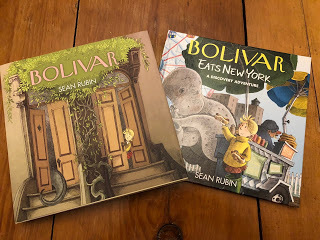
Both of these books are by the same creator and featuring the same characters,
but format-wise are very different books:
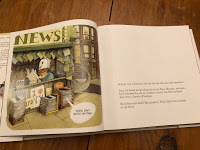
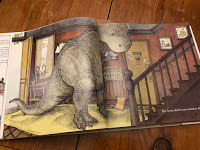
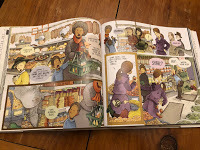
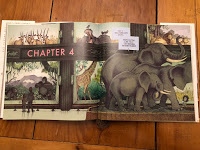
Bolivar, at 224 pages, is more of a comic (panel by panel storytelling) with pages every so often that resemble a picture book. Sean leans into the hybrid idea with having full page illustrations opposite a page with just a few lines of text. He has several scenes that take place on multiple wordless two page spreads or sometimes with word balloons. And he illustrates chapter breaks as though they are cinematically art directed by Wes Anderson.
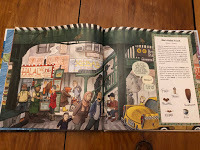
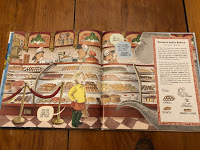
His follow-up Bolivar book (Bolivar is the dinosaur) called Bolivar Eats New York is much slimmer at 24pgs and a very different format. The first few pages are like the comic pages of the original book, but the majority of this volume are two page spreads that have character dialogue in word balloons, an info box about the eatery they are visiting, and then a search-and-find puzzle game to find the various ethnic foods in the larger illustration. The book then transitions back out for comic style pages for the ending.
Encyclopedia Of
Things That Never Were by Michael Page & Robert Ingpen
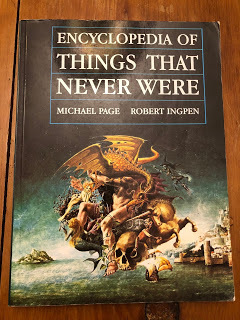
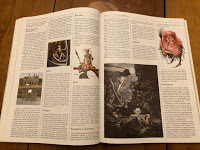
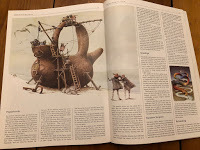
I hesitantly put this book on the list––but ultimately included it because of the volume of illustrations and their balance to the volume of text is a great starting point to talk about Field Guide style illustrated books. The premise is to present a book as though it is a factual text earnestly describing something we the readers know as fiction. Each page is either a full page illustration, a large illustration balanced by text or a series of as many as 3-4 illustrations surrounded by text.
Because this is an 'Encyclopedia' the text is limited to descriptions only and any narrative is the most brief of summaries of folklore or legend. All of the text is typeset with very little in the way of design, which from a art-direction standpoint fits perfectly with the theme being an Encyclopedia.
Faeries by Alan Lee & Brian Froud
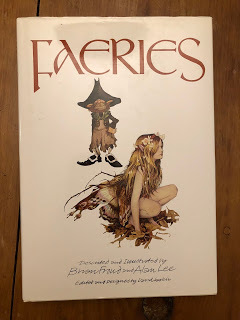


Faeries is a book probably every illustrator has owned since it's publication. It's a great example of the field guide style of books, with a great deal of handwritten text almost like notes taken on an outing. The text mostly serves as descriptions or excerpts of folklore...very little narrative here. And there's an interesting choice how how much of the book is spot illustration on the white page...making this feel very much like a shared naturalist's journal that Froud and Lee shared as they walked the countryside observing and sketching the goings-on of the fay-folk.
Gnomes by Wil Huygen & Rien Poortvliet
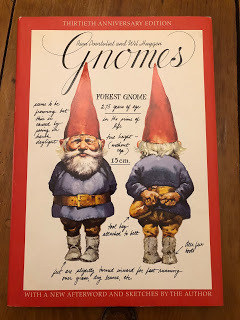
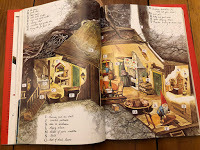
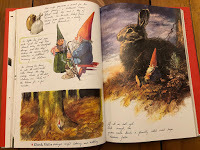
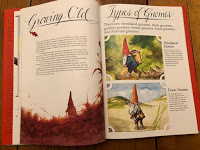
Continuing on with the field guide style books, and one of the best examples of that type of book is Gnomes. This book has it all, diagrams with arrows and measurements, labeled cutaways, scene illustrations, slice-of-life moments...a bit of everything to make the reader believe in a little cultured world of gnomes that we never took the time to notice. The words are blended in both with handwritten and typeset text. And that text not only provide descriptions and notes–– there are also several full narrative tale short stories that are heavily illustrated.
Arthur Spiderwick's Field Guide
to the Fantastical World Around You by Holly Black and Tony DiTerlizzi
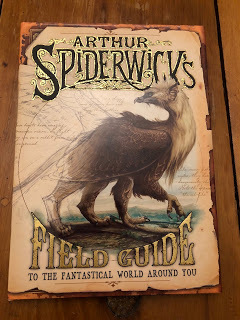
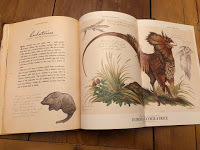
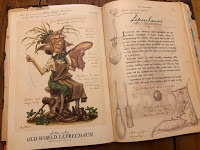
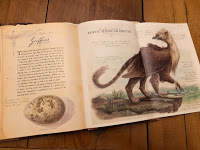
This supplement to book to the Spiderwick Chronicles literally has Field Guide in the title. It's not only a wonderful blend of words and pictures, but the art direction of them––with full page illustrations (some as gatefold pages so the creature feels larger than the book can contain) spot illustrations, & sketches. The page layout with a parchment and worn paper look and font choices that go a long way to make this book feel in-world...like a real book from long ago documenting these beasts. It's amazingly complete feeling because of the design and cohesion. It offeres a wide range of 'study' but not like a sketchbook or traveling journal...more like a softer naturalist's D&D Monster Manual (minus the attack tables).
The Dinotopia Series by James Gurney
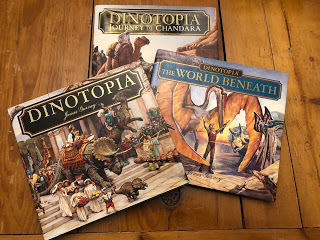 Dinotopia: A Land Apart from Time, The World Beneath, and Journey to Chandara
Dinotopia: A Land Apart from Time, The World Beneath, and Journey to Chandara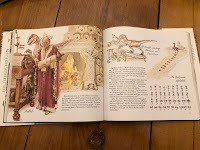
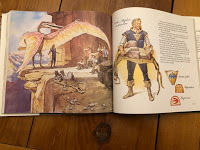
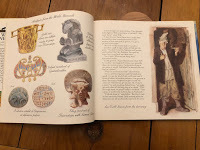
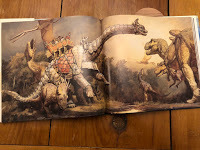
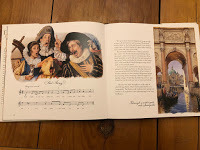
The Dinotopia series is the best blend, the epitome of all of the field guide style books, but with a major backbone of narrative structuring the whole thing together. Gurney combines full page and two page illustrations with spot illustrations, story text, cutaway diagrams, exhibits of in-world findings––even a dinosaur alphabet and musical notation for songs. Dinotopia is the high benchmark for the hybrid words & pictures book, because it balances both so well...integrating them and becoming more than just a picture book or illustrated novel or field guide.
The Griffin and Sabine Series by Nick Bantock
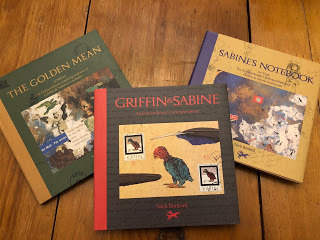 Griffin & Sabine, Sabine's Notebook, & The Golden Mean
Griffin & Sabine, Sabine's Notebook, & The Golden Mean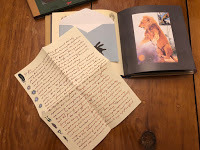
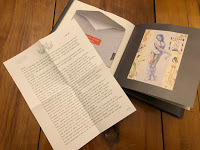

The last entry I'll put on this list is Nick Bantock's Griffin & Sabine series. The premise is that we get to voyeuristically look through correspondence between the title characters. Many of those are removable letters to unfold and carefully replace back into the envelope adhered to the page––while others are non-removable postcards where you flip the page to read the back. Between the typography and the fact that every bit of the stationary, postcards, postage stamps, stickers, ink-stamps, and envelopes has been designed and illustrated by Bantock this series does a sneaky job of combining words and pictures because it's easy to take for granted that those items are all just found objects the author used.
I think it's a fascinating thing to break with convention of book formats and to play with the balance of how to blend together text and art in new ways. I think many creators like the idea at first blush because A) it seems easy––not having to write or draw too much, and/or B) because they want to do something like (fill in the blank of one of the author/illustrators above) did with their book. And those are valid points, but I think the ones that are the most successful of these are in many ways the hardest to achieve...because a hybrid project combining words and pictures needs to be more than what has come before it, or an excuse to fill pages with typography to get out of doing more illustrations or to cut down on word count by adding in illustrations. There needs to be a thematic conceit, an art-designed layout that cements that conceit, and the perfect balance of words and pictures that tell that story in a way where removing any bit of either would not tell the same tale.
Like I said, I pulled these examples from my own bookshelves. I'm sure there are many other great examples out there, and if you have any you'd like to share, please post in the comments section.
2020 Appearances Coming Soon...
Published on November 12, 2019 06:00
November 5, 2019
Flint Friend Reunion
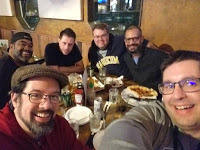 Last week I arranged a reunion with a bunch of my childhood friends. I rented an AirB&B on Lake Michigan and sent out the invite. Of the 8 I asked, 6 could make it---a few even flying in from Boston & Texas. Ryan, one of the guys who couldn't make it, now owns a brewery (Odd13) and shipped us complimentary beer for our time there. These friends were like my brothers when I was growing up. The guy I'd known the longest I met sometime in early elementary school, and the one I've known the shortest I met when I was 17. Two of these guys stood up at my wedding, and one was an usher. We've helped each other through break-ups, created stories and characters together for comics and roleplaying (many of which have or will be featured in The Plotmasters Project), and made movies together at the advent of the home video camera. So please forgive me and indulge me in sharing photos from the trip this blogpost.
Last week I arranged a reunion with a bunch of my childhood friends. I rented an AirB&B on Lake Michigan and sent out the invite. Of the 8 I asked, 6 could make it---a few even flying in from Boston & Texas. Ryan, one of the guys who couldn't make it, now owns a brewery (Odd13) and shipped us complimentary beer for our time there. These friends were like my brothers when I was growing up. The guy I'd known the longest I met sometime in early elementary school, and the one I've known the shortest I met when I was 17. Two of these guys stood up at my wedding, and one was an usher. We've helped each other through break-ups, created stories and characters together for comics and roleplaying (many of which have or will be featured in The Plotmasters Project), and made movies together at the advent of the home video camera. So please forgive me and indulge me in sharing photos from the trip this blogpost.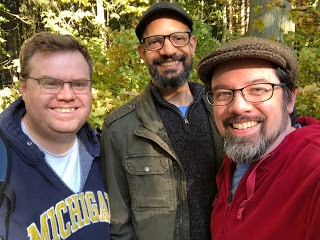 L-R: Emerson, Jesse, & Me (Lieam, Kenzie, and Saxon--even though Emerson & Jesse have swapped color attire)
L-R: Emerson, Jesse, & Me (Lieam, Kenzie, and Saxon--even though Emerson & Jesse have swapped color attire)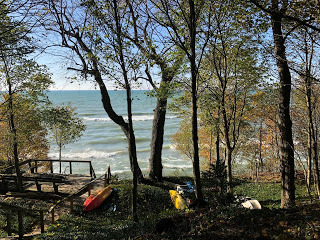 Our view from the back deck of beautiful Lake Michigan
Our view from the back deck of beautiful Lake Michigan(which had wiped out the last of the stairs down to the beach the weekend prior)
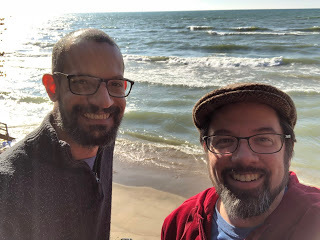 My fellow Plotmaster Jesse & I
My fellow Plotmaster Jesse & I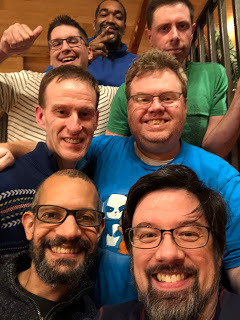 The Whole group that could attend:
The Whole group that could attend:1st row L-R: Jesse Glenn, Me
2nd row L-R: Mike Davis (Rand), Emerson Jones (Lieam)3rd row L-R: Nick Kowalcyk, John Connolly4th row: Lawrence Bradley
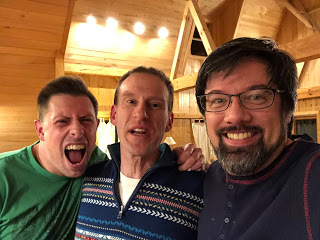 John, Mike & Me
John, Mike & Me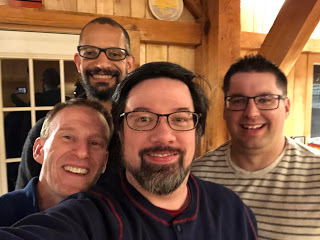 The Cats Trio, The Original Beanie Squad, The Gilkey Warlocks...Jesse, Mike, Me and Nick.
The Cats Trio, The Original Beanie Squad, The Gilkey Warlocks...Jesse, Mike, Me and Nick.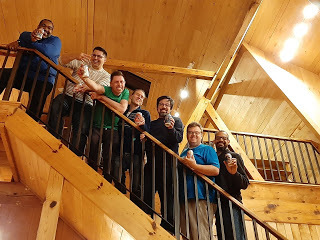 The whole group holding our Odd13 Beers from Ryan
The whole group holding our Odd13 Beers from RyanL-R: Lawrence, Nick, John, Mike, Me, Emerson, Jesse
At one point, Mike picked up my phone and unable to get past the lock screen, opened the camera and took this block of four photos:
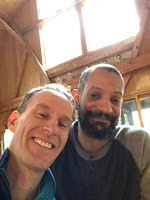
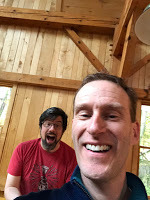
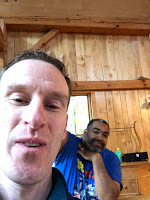
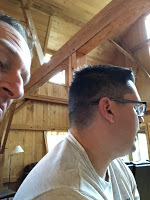
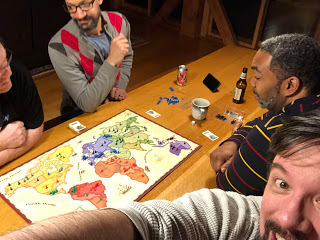 We played some board games together like old times–– RISK!
We played some board games together like old times–– RISK!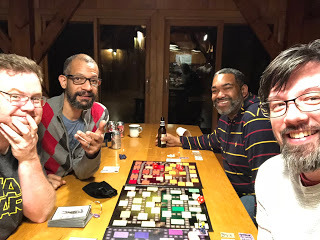 And the board game I made: TOWER!
And the board game I made: TOWER!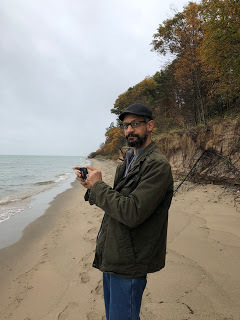 Jesse and I managed to scramble down the sandy bluff past the washed out stairs to take some photos from the beach.
Jesse and I managed to scramble down the sandy bluff past the washed out stairs to take some photos from the beach.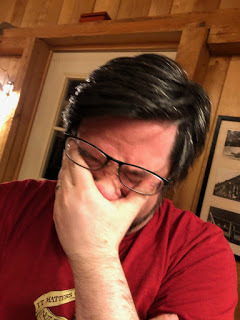 I laughed so hard I cried a few times.
I laughed so hard I cried a few times.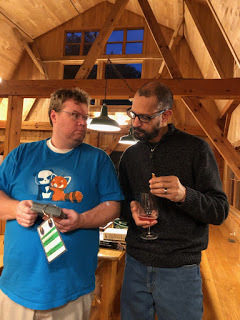 Emerson played a sub-game in Tower called 'Did Jesse or David draw this Monster'
Emerson played a sub-game in Tower called 'Did Jesse or David draw this Monster'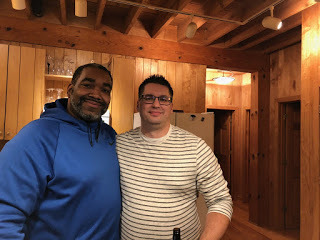 Lawrence and Nick
Lawrence and Nick 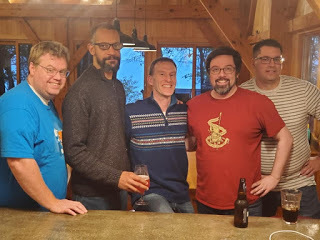 L-R: Emerson, Jesse, Mike, Me, and Nick
L-R: Emerson, Jesse, Mike, Me, and NickIt was a really good five days for me. Not everyone could be there the whole time, but we did have one night and morning where everyone's stay overlapped. We are even talking about trying to do it again next year, and I've reached out to a few of the guys who couldn't make it this time who definitely wanted in next time...I even floated that I could bring all our old home movies where we tried to recreate movies like Back To The Future, The Rocketeer, TMNT, and SNL sketches of the late 80's and early 90's...
2019 Appearances
The Fantastic Workshop Nov. 13-18
Published on November 05, 2019 06:00
October 29, 2019
Folklords Variant Cover Process
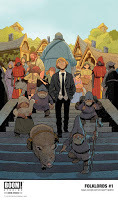 My friend and artist Matt Smith (Barbarian Lord, Lake of Fire) is working on a new creator-owned book titled FOLKLORDS written by Matt Kindt (Grass Kings, Mind MGMT) and I was asked to do a variant cover for an upcoming issue. Folklords is a fantasy/folklore setting where coming-of-age involves going on a quest and our hero Ansel decides to wander from his given quest-path to do the forbidden––follow his own quest to find the Folklords and answer why he sees visions of tailored suits and technology.
My friend and artist Matt Smith (Barbarian Lord, Lake of Fire) is working on a new creator-owned book titled FOLKLORDS written by Matt Kindt (Grass Kings, Mind MGMT) and I was asked to do a variant cover for an upcoming issue. Folklords is a fantasy/folklore setting where coming-of-age involves going on a quest and our hero Ansel decides to wander from his given quest-path to do the forbidden––follow his own quest to find the Folklords and answer why he sees visions of tailored suits and technology.Matt Smith knew of my Gnomevember drawings from a few years back and asked if I'd specifically like to do a cover featuring the Folklords equivalents seen here on issue 1's cover with his artwork.
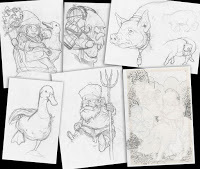 I loved the idea of getting to do a Gnomish piece for this book, and so I started with pencil drawings of a few Gnomes & their livestock. In Folklords, the Gnomes are farmers who have been pushed out of the fertile land and into rocky territory where they live in a disgruntled state. I took my cues for the trio I was drawing from Matt's cover art (as well as a character lineup sheet he provided me with). I wasn't sure of the overall composition, but knew that three Gnomes would give enough variety and a sense of a balanced composition. The last drawing here of the rock carvings came later––after the next step, and I'll talk about it then.
I loved the idea of getting to do a Gnomish piece for this book, and so I started with pencil drawings of a few Gnomes & their livestock. In Folklords, the Gnomes are farmers who have been pushed out of the fertile land and into rocky territory where they live in a disgruntled state. I took my cues for the trio I was drawing from Matt's cover art (as well as a character lineup sheet he provided me with). I wasn't sure of the overall composition, but knew that three Gnomes would give enough variety and a sense of a balanced composition. The last drawing here of the rock carvings came later––after the next step, and I'll talk about it then.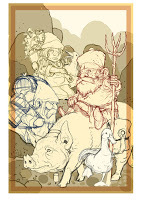 With the characters and animals all penciled I scanned in my drawings into Photoshop to compose the image. Because each drawing is a separate scan, I can resize, rotate, adjust, and tint them all individually to carefully puzzle-piece together the layout and make fixes where necessary (the Gnome on the pig needed his leg sifted over a bit and I needed to join the pig's head to the much smaller body drawing I'd sketched. For the rockly landscape, I just quickly blobbed in some tan rocks to imply the landscape and the depth of field I was aiming for. The editor on the book asked me to add some runic carvings to the rocks to help it feel specifically Folklords-ish. So I printed this out at 8.5" x 11" and on a light pad and another sheet of paper, did the above drawing of the rock carvings to be applied to my layout before inking.
With the characters and animals all penciled I scanned in my drawings into Photoshop to compose the image. Because each drawing is a separate scan, I can resize, rotate, adjust, and tint them all individually to carefully puzzle-piece together the layout and make fixes where necessary (the Gnome on the pig needed his leg sifted over a bit and I needed to join the pig's head to the much smaller body drawing I'd sketched. For the rockly landscape, I just quickly blobbed in some tan rocks to imply the landscape and the depth of field I was aiming for. The editor on the book asked me to add some runic carvings to the rocks to help it feel specifically Folklords-ish. So I printed this out at 8.5" x 11" and on a light pad and another sheet of paper, did the above drawing of the rock carvings to be applied to my layout before inking.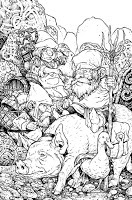 Once the rock carvings were added and all the parties involved gave their approvals, I started on the inks. I printed out the cover digital layout (basically the above image, but with the rock textures added) and taped it to the back of a sheet of Strathmore 300 series bristol. On my Huion light pad I could ink the piece using the printout as a guide. I used Copic Multiliner SP pens (the 0.7 & 0.3 nibs) to add in all the texture & line weight. I may have overdone the inks on the rock carvings...and it made me worry as I looked at the piece and it seemed very busy and lacked the depth of the rough...
Once the rock carvings were added and all the parties involved gave their approvals, I started on the inks. I printed out the cover digital layout (basically the above image, but with the rock textures added) and taped it to the back of a sheet of Strathmore 300 series bristol. On my Huion light pad I could ink the piece using the printout as a guide. I used Copic Multiliner SP pens (the 0.7 & 0.3 nibs) to add in all the texture & line weight. I may have overdone the inks on the rock carvings...and it made me worry as I looked at the piece and it seemed very busy and lacked the depth of the rough...I inked a fair bit of this live on my Twitch stream.
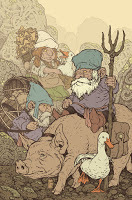 When starting the coloring process to help with the depth issue I established LOTS of color holds. For those who don't know, color holds are areas where I want the inkwork to be a painted color rather than black. And here I made one for every degree of depth I wanted to push: The pig farmer depth, the barrel-gnome depth, the lady with the ducks depth, behind the lady depth, and the far back rocks with no details.
When starting the coloring process to help with the depth issue I established LOTS of color holds. For those who don't know, color holds are areas where I want the inkwork to be a painted color rather than black. And here I made one for every degree of depth I wanted to push: The pig farmer depth, the barrel-gnome depth, the lady with the ducks depth, behind the lady depth, and the far back rocks with no details.Then I added in flat colors to the piece basing the palate of the characters from Matt's control art he sent over.
The last step was to render all the color. I used the dodge and burn tools with a stock textured brush mainly...but in a few areas, I did something I rarely do, put away the mouse, pull out the tablet and use the paint brush tool...I did this on their faces where I needed a bit more control over the shading.
Most of the coloring work here was about balancing out the values and hues to re-create the sense of depth and the Grapes-of-Wrath-Dustbowl mood I saw in my rough, but lost on my inks.
FOLKLORDS #1 will be available for sale November 13 in comic shops. This cover will be on a later issue.
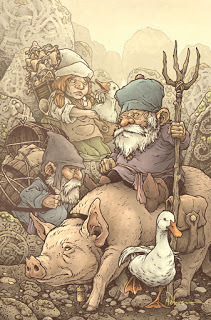
2019 Appearances
The Fantastic Workshop Nov. 13-18
Published on October 29, 2019 06:00
October 22, 2019
New Convention Backdrop
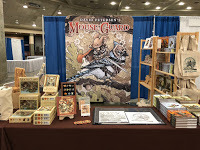 This past weekend I set-up my new Convention backdrop for the first time at Baltimore Comic Con! It's a 6' x 8' tension fabric zip-stand (by Blue Wave Printing). I don't know that I'll use it at conventions other than the ones where I'll be at a booth (Emerald City, SDCC, and Baltimore as-of now), but I wanted to share the new look as well as the art-steps it took to get there.
This past weekend I set-up my new Convention backdrop for the first time at Baltimore Comic Con! It's a 6' x 8' tension fabric zip-stand (by Blue Wave Printing). I don't know that I'll use it at conventions other than the ones where I'll be at a booth (Emerald City, SDCC, and Baltimore as-of now), but I wanted to share the new look as well as the art-steps it took to get there.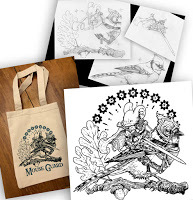
A few weeks ago I did a blogpost all about my new tote-bag (going into my online store shortly), and I liked the artwork for that tone so well I considered trying it for the banner. But even colored, it was going to have too much negative space to draw people into Mouse Guard from across a convention hall when on my backdrop. I tried a few other Mouse Guard pieces from sketchbooks and covers, and I ultimately arrived back at this piece, deciding that I just needed to fill that empty space with background leaves, branches, and acorns...
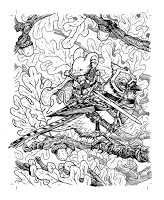
So, on my light pad, I was able to place a blank sheet of bristol board over a printout copy of my tote design, and fill in all the background area.
I did this live on my Twitch channel, and the video should be available to watch on my videos page for a while longer: https://www.twitch.tv/davidpetersen/videos
In the image to the left, I've made the background inks grey to make them easier to pick-out from the original art of the tote.
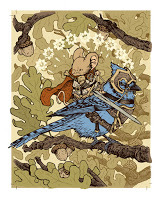 When the inks were done, I scanned them into Photoshop and into a file where I already had the tote design placed. I got the new inkwork to line up with the old, and then started coloring the piece. This process is called 'flatting' because all you are doing is establishing the flat color areas.
When the inks were done, I scanned them into Photoshop and into a file where I already had the tote design placed. I got the new inkwork to line up with the old, and then started coloring the piece. This process is called 'flatting' because all you are doing is establishing the flat color areas.Because the background inks were scanned separately, it was very easy for me to paint that linework as a lighter color to help push it back further into the background.
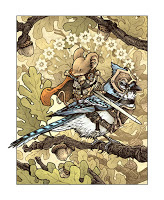
Then came the final color rendering. In this step I used a textured brush with the dodge and burn tools in Photoshop to add all my highlights and shadows.
This step was also something I broadcast on my Twitch channel as I worked: https://www.twitch.tv/davidpetersen/videos
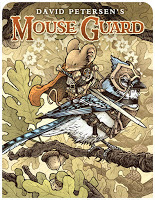
Once the colors were done, the Mouse Guard logo and my name were added in (with a few effects and tricks to help make them more readable against the leafy background) and placed into the template provided by Blue Wave Printing so I could send the file off to them.
Since Baltimore was the last convention of the year for me, I won't get to use it again (and folks won't see it in person) until 2020 (starting with Emerald City Comic Con!
2019 Appearances
The Fantastic Workshop Nov. 13-18
Published on October 22, 2019 06:00
David Petersen's Blog
- David Petersen's profile
- 339 followers
David Petersen isn't a Goodreads Author
(yet),
but they
do have a blog,
so here are some recent posts imported from
their feed.



